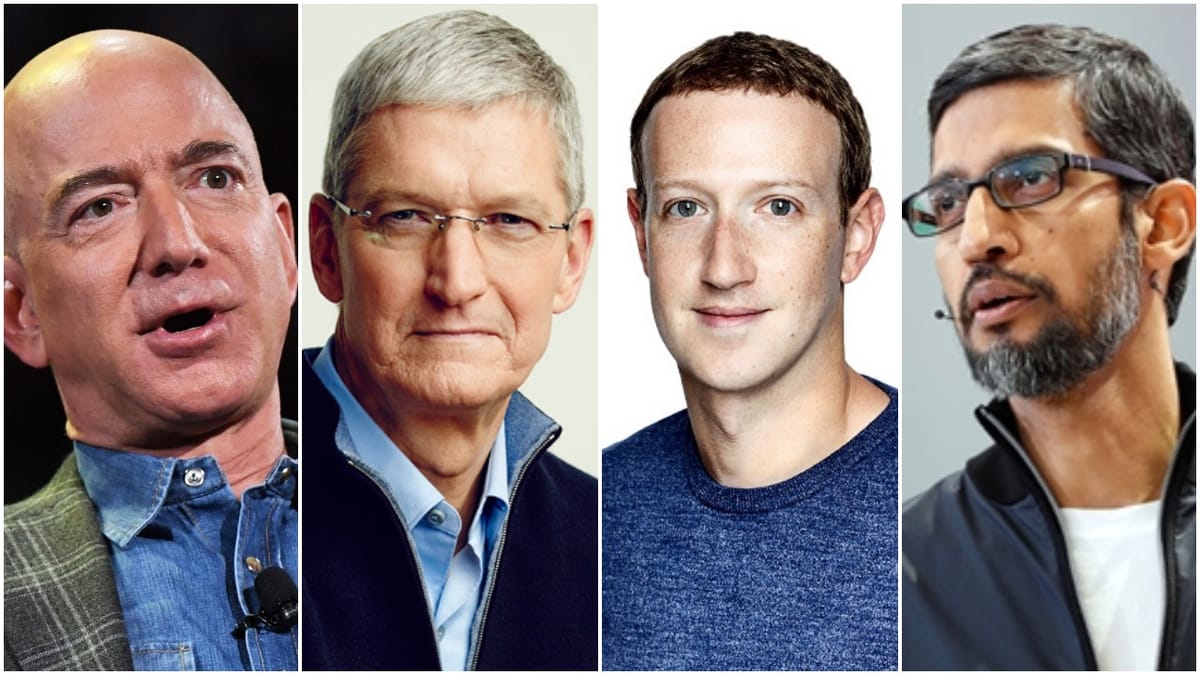Big Tech’s Response to Coronavirus: Face Masks, Hiring Binges, Free Web Sites and Cash Donations
April 2, 2020 – Big technology companies have been closely scrutinized by legislators and the executive branch in Washington for at least two years now. But this “techlash” is largely forgotten in the wake of the coronavirus pandemic. Whether the future looks back on big tech as a savior or a vultur

April 2, 2020 – Big technology companies have been closely scrutinized by legislators and the executive branch in Washington for at least two years now. But this “techlash” is largely forgotten in the wake of the coronavirus pandemic.
Whether the future looks back on big tech as a savior or a vulture depends much on how these companies – particularly Amazon, Apple, Facebook and Google –act and react in the coming weeks and months.
To see how they have been acting since the pandemic emerged, Broadband Breakfast has assembled this inventory of their actions since the import of the new coronavirus and the COVID-19 disease has come to light.
A timeline of how the big four of big tech have responded to coronavirus
Amazon has made its software largely available to governments, schools, and health workers and has also donated several millions of dollars to fighting the epidemic. The company has seemed to have pounced on a suddenly vulnerable economy, announcing that it will hire 100,000 new warehouse workers while other companies began mass layoffs. And it has not escaped criticism regarding its handling of those workers’ health and safety.
In general, Apple seems to have had a single-minded obsession with donating as many masks as possible.
Facebook has donated several hundred million dollars to aspects of the coronavirus response, ranging from combatting misinformation to donating ad space to health authorities. Its newly unveiled Community Help feature, which connects Facebook users offering help with those requesting it, is untested but widely-anticipated.
Of the big four, Google has donated the most to address the coronavirus, with a contribution of $800 million for small businesses, governments, and health workers. It has also suffered in the press when it got caught in the crossfire between the Trump administration and the press over the coronavirus website affair.
Amazon
March 16th: Amazon announces it will hire 100,000 employees amid pandemic, according to the New York Times.
March 18th: The Atlantic reports that Amazon confirmed the first case of coronavirus in an American warehouse, in Queens, New York.
March 20th: Amazon announces it will reduce the quality of its streaming service Amazon Prime Video in Europe, following YouTube’s footsteps, according to The Verge.
March 20th: Amazon donates $20 million to research and development of coronavirus testing, announced by Amazon blog post.
March 22nd: Trump announces during daily coronavirus task force conference that Amazon, as part of a consortium comprising Google, Microsoft, and IBM, will be offering hundreds of petaflops worth of computational power in analyzing projects in epidemiology, bioinformatics and molecular modeling according to TechCrunch.
March 25th: Amazon provides its Amazon Web Services “cloud technologies and technical expertise” to help the World Health Organization aggregate epidemiological data.
March 25th: Amazon offers its Future Engineer collection of computer science literacy courses to schools.
March 27th: Amazon donates $4 million to British Red Cross and several British government institutions.
March 28th: Amazon donates its AWS infrastructure technology to help Boston Children’s Hospital track the spread of coronavirus through the use of crowdsourcing maps.
March 30th: Amazon grants $5 million to 400 Seattle small businesses.
March 30th: Amazon provides 73,000 meals to medically vulnerable residents in Seattle in conjunction with local catering business Gourmondo.
March 30th: Amazon remotely upgrades Alexa to answer the question “Alexa, what do I do if I think I have coronavirus?”
March 31st: Amazon fires warehouse worker who staged a walkout at a Staten Island warehouse. New York Attorney General Letitia James, who is already leading an investigation of Facebook with eight other state attorneys general, calls for an investigation.
April 1st: Amazon formally recommends “All corporate office employees who work in a capacity that can be done from home are recommended to do so through April 24.”
April 2nd: Amazon announces it will release a bevy of webinars “on a variety of remote learning topics” for free available on April 6th.
April 2nd: Amazon donates infrastructure technology that will allow the aggregation of information across formerly siloed British National Health Service departments. They will share data such as occupancy levels and wait times at specific hospitals.
Apple
Sometime in early March: Apple issues a work-at-home order to its employees, loosening its notorious policy of secrecy surrounding unreleased products, such as having designers work in rooms with blacked out windows, according to a report by Bloomberg.
March 13th: Apple closes all retail stores outside of China in Tim Cook’s statement to the public. In the same letter, Apple announces its donations have reached $15 million for coronavirus-related efforts.
March 19th: Tim Cook announces via Twitter that Apple will be donating an undisclosed amount of money to Protezione Civile, Italy’s official emergency response task force for the coronavirus.
March 20th: 9to5Mac is the first to notice Apple’s unannounced decision to downgrade streaming resolution on its European customers’ Apple TV+s.
March 25th: Tim Cook announces via Twitter that Apple has sourced 10 million masks for the U.S. and millions more for Europe.
March 27th: Apple releases COVID-19 Screening website in conjunction with the CDC and the White House that tells users about the disease, testing, and what steps they can take.
April 1st: Apple donates $20 million to China’s coronavirus efforts, Tim Cook announced through China’s equivalent of Twitter, Weibo.
April 1st: Apple donates 2 million masks to the State of New York according to a tweet by Governor Andrew Cuomo .
April 2nd: Apple teams up with actor Leonardo DiCaprio to raise $15 million for food charity according to Business Insider. As of this writing, they have already raised $12 million.
January 30th: Facebook announces a more aggressive stance on removing misinformation regarding coronavirus following its declaration by the World Health Organization as a public health emergency of international concern. Facebook also begins offering free ad credits for organizations that advertise responsibly on the coronavirus.
February 26th: Facebook begins promoting links to WHO at the top of search results on coronavirus.
March 13th: CEO Mark Zuckerberg matches $20 million worth of donations to WHO and the Center for Disease Control through a Facebook post.
March 16th: Facebook, along with Google, Microsoft, and other tech companies, releases a vague statement promising to help “people stay connected,” “[elevate] authoritative content,” and “[share] critical updates,” according to The Verge.
March 17th: Facebook donates $1 million to the International Fact-Checking Network and $1 million in grant money to local news organizations across the U.S. and Canada to support their coverage of coronavirus.
March 17th: Facebook restores all posts that were incorrectly flagged for spam following a report by The Verge, announced through a Twitter post by Guy Rosen, Facebook’s vice president of integrity.
March 18th: Facebook doubles server capacity for WhatsApp.
March 18th: Chief Operating Officer Sheryl Sandberg announces through a Facebook post that the company will offer $100 million in cash grants and ad credits for “up to 30,000 eligible small businesses in over 30 countries where we operate.”
March 18th: Zuckerberg hosts press call where he announces Coronavirus Information Center feature in the Facebook News Feed. He also announces that Facebook will give governments and emergency services free access to work collaboration tool Facebook Workplace for 12 months.
Sometime between March 19th and March 23rd : Facebook data scientist Ranjan Subramanian releases internal report acquired by The New York Times showing a huge uptick in news clicks through Facebook Newsfeed, which had been declining for years. The uptick in new clicks was specifically for “high-quality” and local news.
March 19th– Facebook sends its content reviewers packing. Facebook shifts content review work from contractors to full time employees.
March 22nd: Zuckerberg announces through a Facebook post donation of 720,000 masks reserved for their employees in case of forest fires. Although Facebook has only 45,000 employees, a Facebook spokesman said that “the masks were from our emergency disaster reserve and many had been acquired due to the recent dangerous California wildfires. As recommended, Facebook has emergency supplies like food, water, masks and other supplies on hand like many other companies.”
March 23rd: Facebook announces it will temporarily downgrade video streaming quality on Facebook and Instagram in Europe and Latin America, according to Reuters.
March 23rd– March 26th: Facebook co-hosts a COVID-19 Global Hackathon with the aim to foster the development of software that addresses “some of the challenges related to the current coronavirus pandemic.” Winners will be announced on April 10.
March 26th: Facebook launches Get Digital, an online resource that helps teach kids how to responsibly use the internet.
March 26th: Facebook launches its “Messenger Coronavirus Community Hub,” a webpage that explains how to get the most out of Facebook Messenger.
March 29th: Facebook invests $100 million in news industry to support publishers “at a time when advertising revenue is declining.”
March 30th: Facebook donates $25 million to support healthcare workers.
March 31st: Facebook launches its Community Help feature, making it easier for users to both request and offer services such as delivering groceries or providing transportation.
March 3rd: Google makes its video-conferencing tool Hangouts Meet available for free for G Suite Users and schools and expands its hosting maximum to 250 participants.
March 13th: Trump blindsides Google by announcing a thorough coronavirus screening website. As of March 13th, Google has developed no such thing.
March 15th: CEO of Alphabet, Google’s parent company, Sundar Pichai clarifies the situation through a blog post, insisting that Google is creating a very straightforward database of resources.
March 20th: Google subsidiary YouTube announces it will downgrade it its video streaming resolution in Europe following a Twitter plea from European Commissioner Thierry Breton.
March 21st: Google rolls out the coronavirus information website made notorious by Trump’s surprise and confusing announcement at the White House Rose Garden. The website hardly resembles the website Trump and Federal coronavirus response coordinator Dr. Deborah Birx described using a big, fictional chart.
March 21st: Google redesigns it search page to highlight content from health authorities like CDC and WHO.
March 22nd: Trump announces during his daily Coronavirus Task Force press conference that Google, as part of a consortium comprising Amazon, Microsoft, and IBM, will offer hundreds of petaflops worth of computational power for the analysis projects in epidemiology, bioinformatics and molecular modeling according to TechCrunch.
March 24th: YouTube announces it will be lowering streaming quality around the world according to a report from Bloomberg.
March 27th: Pichai announces $800 million donation to small businesses, governments, and health workers via blog post.
April 2nd: Google donates $6.5 million to fund fact-checking organizations in an effort to combat misinformation
April 2nd: Google creates a public health dataset built on the back of its BigQuery data warehouse and opens the dataset to researchers.








